Impact of Taxation on Foreign Direct Investment in Developing Nations
VerifiedAdded on 2021/06/18
|8
|2905
|459
Report
AI Summary
This report investigates the influence of taxation on Foreign Direct Investment (FDI) decisions in developing economies, specifically focusing on India and Bangladesh. The study examines the relationship between various tax variables, including consumption tax, income tax, import tariffs, and business taxes, and their impact on FDI inflow. The research employs a secondary data analysis approach, utilizing time series data from both countries over a 10-year period, and will use regression analysis to determine the correlations. The report reviews existing literature, highlighting the debate on whether tax incentives effectively attract FDI, and formulates a hypothesis that there is no significant impact of taxation on FDI decisions. The methodology includes data collection from official government websites and international agencies, followed by statistical analysis and interpretation of the results in the context of the literature review. The study aims to offer insights into how tax policy changes can affect the overall economic growth of developing economies, and to provide a comparative analysis of the impact of taxation on FDI in a large versus a small country.
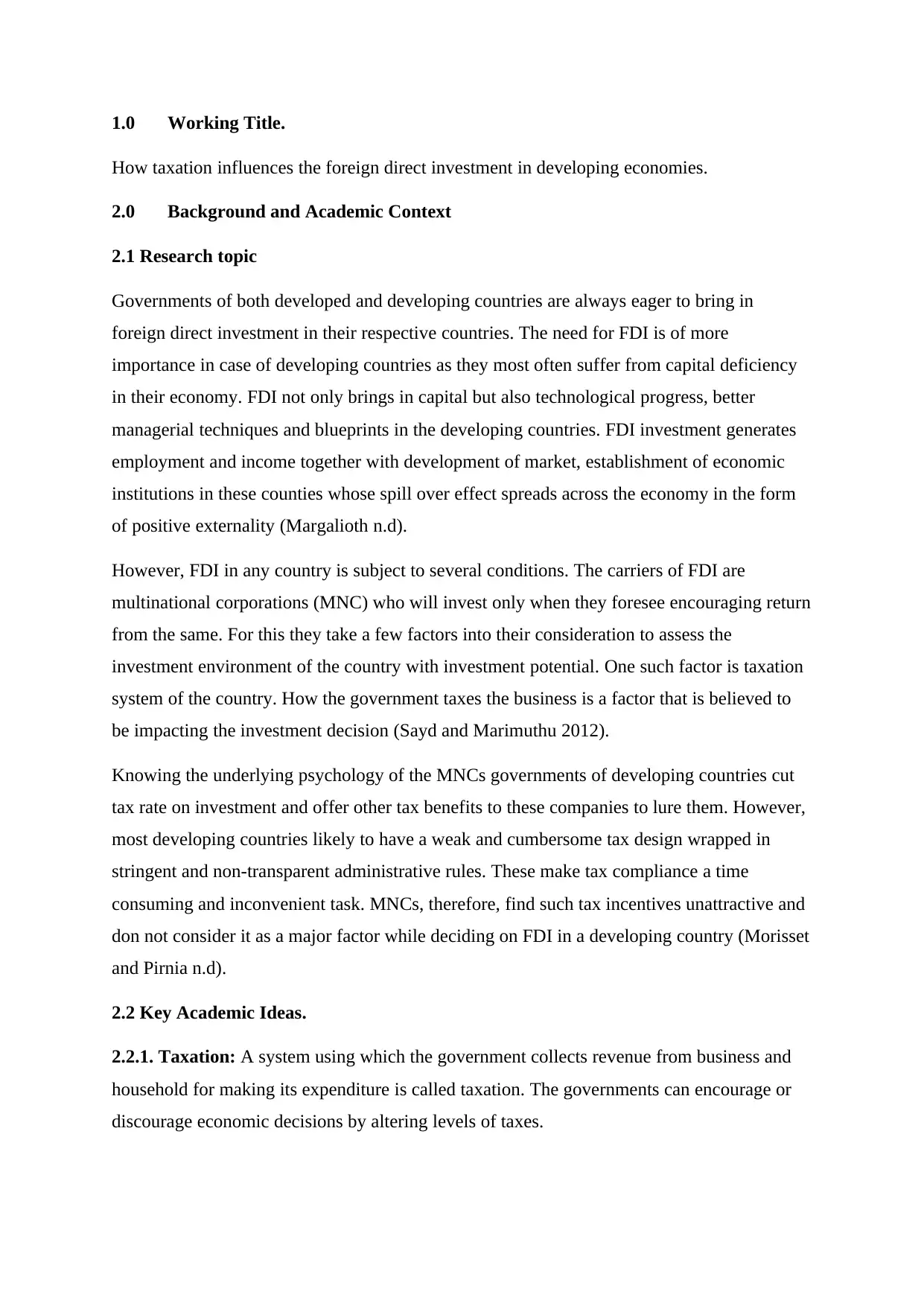
1.0 Working Title.
How taxation influences the foreign direct investment in developing economies.
2.0 Background and Academic Context
2.1 Research topic
Governments of both developed and developing countries are always eager to bring in
foreign direct investment in their respective countries. The need for FDI is of more
importance in case of developing countries as they most often suffer from capital deficiency
in their economy. FDI not only brings in capital but also technological progress, better
managerial techniques and blueprints in the developing countries. FDI investment generates
employment and income together with development of market, establishment of economic
institutions in these counties whose spill over effect spreads across the economy in the form
of positive externality (Margalioth n.d).
However, FDI in any country is subject to several conditions. The carriers of FDI are
multinational corporations (MNC) who will invest only when they foresee encouraging return
from the same. For this they take a few factors into their consideration to assess the
investment environment of the country with investment potential. One such factor is taxation
system of the country. How the government taxes the business is a factor that is believed to
be impacting the investment decision (Sayd and Marimuthu 2012).
Knowing the underlying psychology of the MNCs governments of developing countries cut
tax rate on investment and offer other tax benefits to these companies to lure them. However,
most developing countries likely to have a weak and cumbersome tax design wrapped in
stringent and non-transparent administrative rules. These make tax compliance a time
consuming and inconvenient task. MNCs, therefore, find such tax incentives unattractive and
don not consider it as a major factor while deciding on FDI in a developing country (Morisset
and Pirnia n.d).
2.2 Key Academic Ideas.
2.2.1. Taxation: A system using which the government collects revenue from business and
household for making its expenditure is called taxation. The governments can encourage or
discourage economic decisions by altering levels of taxes.
How taxation influences the foreign direct investment in developing economies.
2.0 Background and Academic Context
2.1 Research topic
Governments of both developed and developing countries are always eager to bring in
foreign direct investment in their respective countries. The need for FDI is of more
importance in case of developing countries as they most often suffer from capital deficiency
in their economy. FDI not only brings in capital but also technological progress, better
managerial techniques and blueprints in the developing countries. FDI investment generates
employment and income together with development of market, establishment of economic
institutions in these counties whose spill over effect spreads across the economy in the form
of positive externality (Margalioth n.d).
However, FDI in any country is subject to several conditions. The carriers of FDI are
multinational corporations (MNC) who will invest only when they foresee encouraging return
from the same. For this they take a few factors into their consideration to assess the
investment environment of the country with investment potential. One such factor is taxation
system of the country. How the government taxes the business is a factor that is believed to
be impacting the investment decision (Sayd and Marimuthu 2012).
Knowing the underlying psychology of the MNCs governments of developing countries cut
tax rate on investment and offer other tax benefits to these companies to lure them. However,
most developing countries likely to have a weak and cumbersome tax design wrapped in
stringent and non-transparent administrative rules. These make tax compliance a time
consuming and inconvenient task. MNCs, therefore, find such tax incentives unattractive and
don not consider it as a major factor while deciding on FDI in a developing country (Morisset
and Pirnia n.d).
2.2 Key Academic Ideas.
2.2.1. Taxation: A system using which the government collects revenue from business and
household for making its expenditure is called taxation. The governments can encourage or
discourage economic decisions by altering levels of taxes.
Paraphrase This Document
Need a fresh take? Get an instant paraphrase of this document with our AI Paraphraser
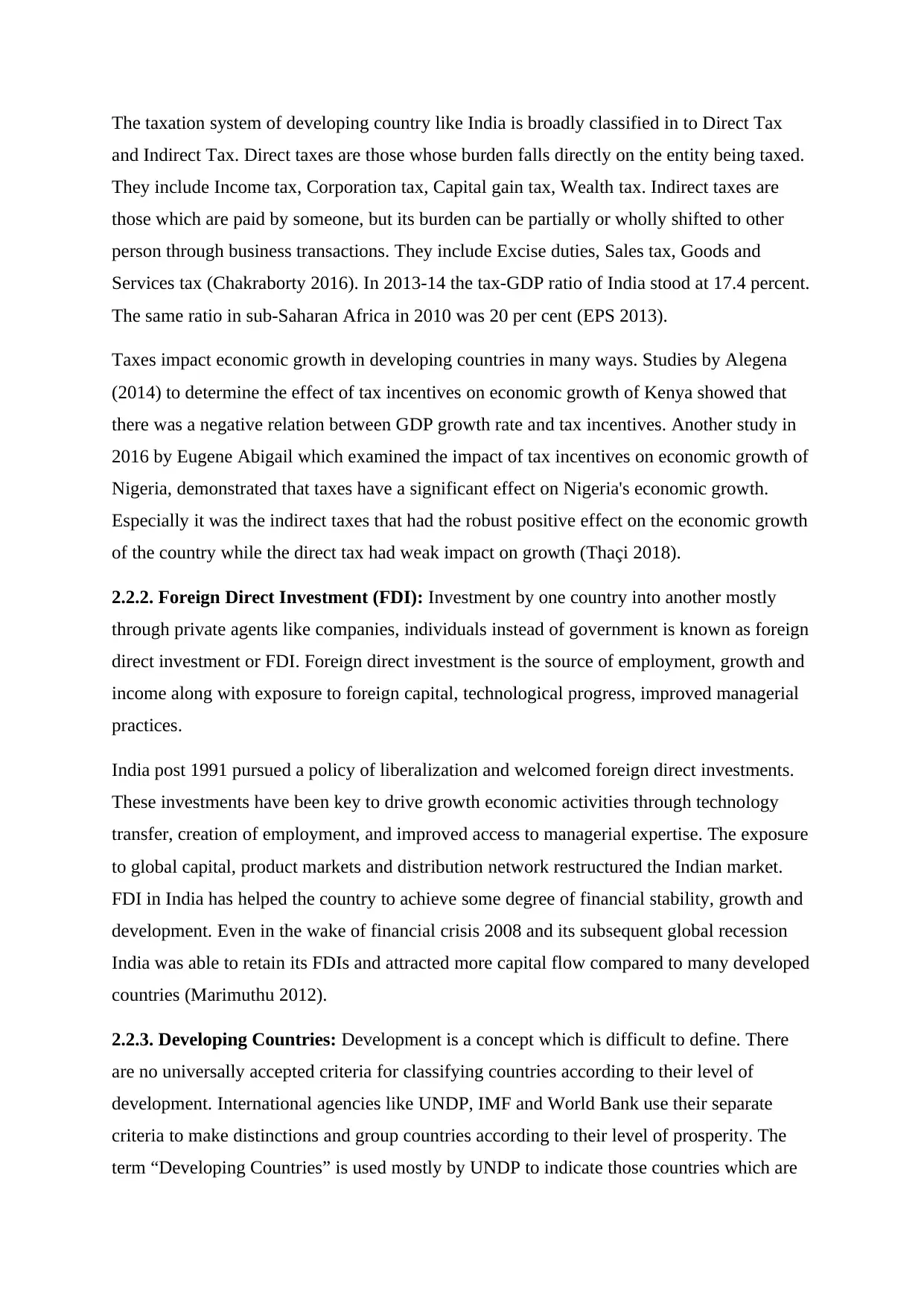
The taxation system of developing country like India is broadly classified in to Direct Tax
and Indirect Tax. Direct taxes are those whose burden falls directly on the entity being taxed.
They include Income tax, Corporation tax, Capital gain tax, Wealth tax. Indirect taxes are
those which are paid by someone, but its burden can be partially or wholly shifted to other
person through business transactions. They include Excise duties, Sales tax, Goods and
Services tax (Chakraborty 2016). In 2013-14 the tax-GDP ratio of India stood at 17.4 percent.
The same ratio in sub-Saharan Africa in 2010 was 20 per cent (EPS 2013).
Taxes impact economic growth in developing countries in many ways. Studies by Alegena
(2014) to determine the effect of tax incentives on economic growth of Kenya showed that
there was a negative relation between GDP growth rate and tax incentives. Another study in
2016 by Eugene Abigail which examined the impact of tax incentives on economic growth of
Nigeria, demonstrated that taxes have a significant effect on Nigeria's economic growth.
Especially it was the indirect taxes that had the robust positive effect on the economic growth
of the country while the direct tax had weak impact on growth (Thaçi 2018).
2.2.2. Foreign Direct Investment (FDI): Investment by one country into another mostly
through private agents like companies, individuals instead of government is known as foreign
direct investment or FDI. Foreign direct investment is the source of employment, growth and
income along with exposure to foreign capital, technological progress, improved managerial
practices.
India post 1991 pursued a policy of liberalization and welcomed foreign direct investments.
These investments have been key to drive growth economic activities through technology
transfer, creation of employment, and improved access to managerial expertise. The exposure
to global capital, product markets and distribution network restructured the Indian market.
FDI in India has helped the country to achieve some degree of financial stability, growth and
development. Even in the wake of financial crisis 2008 and its subsequent global recession
India was able to retain its FDIs and attracted more capital flow compared to many developed
countries (Marimuthu 2012).
2.2.3. Developing Countries: Development is a concept which is difficult to define. There
are no universally accepted criteria for classifying countries according to their level of
development. International agencies like UNDP, IMF and World Bank use their separate
criteria to make distinctions and group countries according to their level of prosperity. The
term “Developing Countries” is used mostly by UNDP to indicate those countries which are
and Indirect Tax. Direct taxes are those whose burden falls directly on the entity being taxed.
They include Income tax, Corporation tax, Capital gain tax, Wealth tax. Indirect taxes are
those which are paid by someone, but its burden can be partially or wholly shifted to other
person through business transactions. They include Excise duties, Sales tax, Goods and
Services tax (Chakraborty 2016). In 2013-14 the tax-GDP ratio of India stood at 17.4 percent.
The same ratio in sub-Saharan Africa in 2010 was 20 per cent (EPS 2013).
Taxes impact economic growth in developing countries in many ways. Studies by Alegena
(2014) to determine the effect of tax incentives on economic growth of Kenya showed that
there was a negative relation between GDP growth rate and tax incentives. Another study in
2016 by Eugene Abigail which examined the impact of tax incentives on economic growth of
Nigeria, demonstrated that taxes have a significant effect on Nigeria's economic growth.
Especially it was the indirect taxes that had the robust positive effect on the economic growth
of the country while the direct tax had weak impact on growth (Thaçi 2018).
2.2.2. Foreign Direct Investment (FDI): Investment by one country into another mostly
through private agents like companies, individuals instead of government is known as foreign
direct investment or FDI. Foreign direct investment is the source of employment, growth and
income along with exposure to foreign capital, technological progress, improved managerial
practices.
India post 1991 pursued a policy of liberalization and welcomed foreign direct investments.
These investments have been key to drive growth economic activities through technology
transfer, creation of employment, and improved access to managerial expertise. The exposure
to global capital, product markets and distribution network restructured the Indian market.
FDI in India has helped the country to achieve some degree of financial stability, growth and
development. Even in the wake of financial crisis 2008 and its subsequent global recession
India was able to retain its FDIs and attracted more capital flow compared to many developed
countries (Marimuthu 2012).
2.2.3. Developing Countries: Development is a concept which is difficult to define. There
are no universally accepted criteria for classifying countries according to their level of
development. International agencies like UNDP, IMF and World Bank use their separate
criteria to make distinctions and group countries according to their level of prosperity. The
term “Developing Countries” is used mostly by UNDP to indicate those countries which are
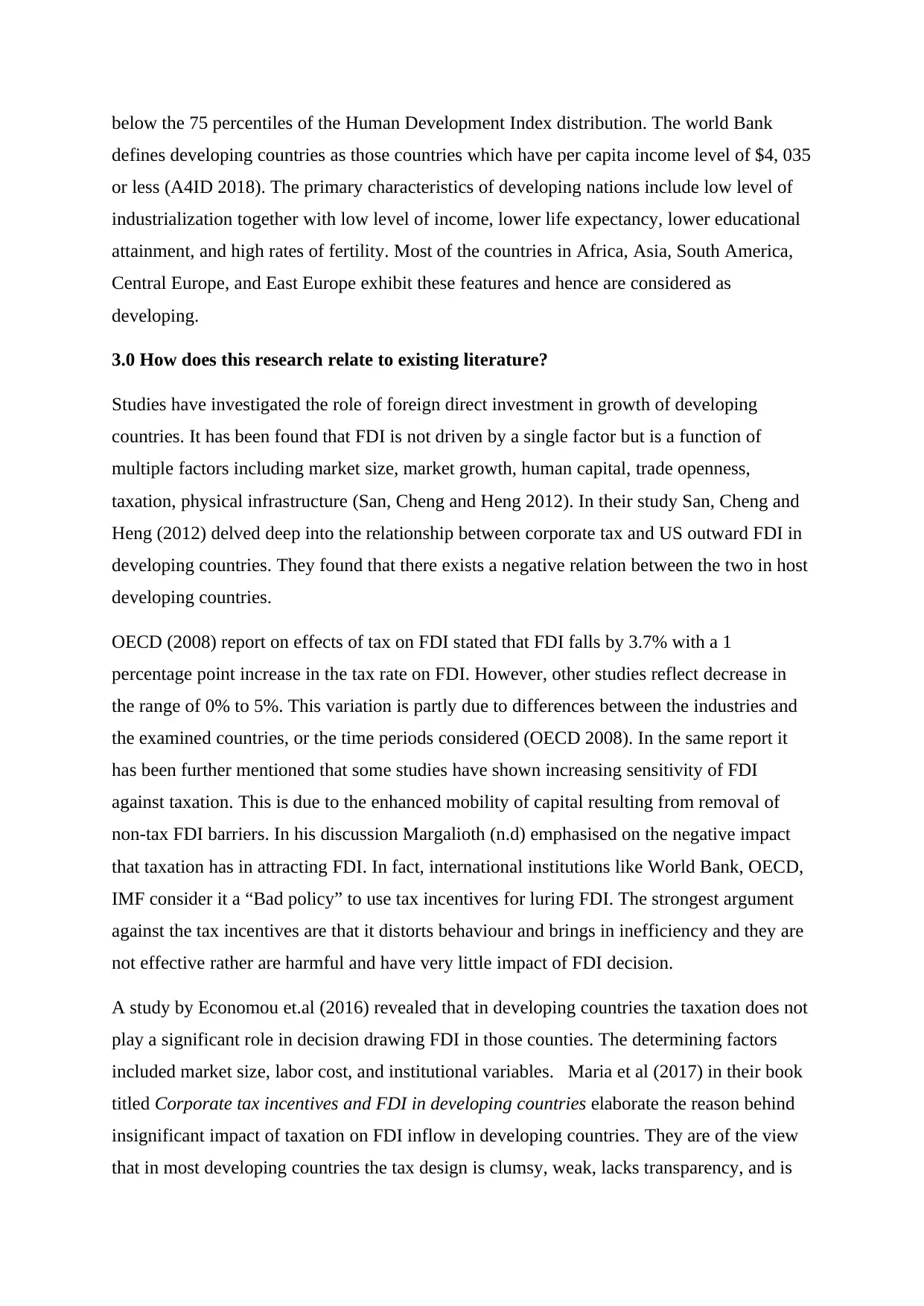
below the 75 percentiles of the Human Development Index distribution. The world Bank
defines developing countries as those countries which have per capita income level of $4, 035
or less (A4ID 2018). The primary characteristics of developing nations include low level of
industrialization together with low level of income, lower life expectancy, lower educational
attainment, and high rates of fertility. Most of the countries in Africa, Asia, South America,
Central Europe, and East Europe exhibit these features and hence are considered as
developing.
3.0 How does this research relate to existing literature?
Studies have investigated the role of foreign direct investment in growth of developing
countries. It has been found that FDI is not driven by a single factor but is a function of
multiple factors including market size, market growth, human capital, trade openness,
taxation, physical infrastructure (San, Cheng and Heng 2012). In their study San, Cheng and
Heng (2012) delved deep into the relationship between corporate tax and US outward FDI in
developing countries. They found that there exists a negative relation between the two in host
developing countries.
OECD (2008) report on effects of tax on FDI stated that FDI falls by 3.7% with a 1
percentage point increase in the tax rate on FDI. However, other studies reflect decrease in
the range of 0% to 5%. This variation is partly due to differences between the industries and
the examined countries, or the time periods considered (OECD 2008). In the same report it
has been further mentioned that some studies have shown increasing sensitivity of FDI
against taxation. This is due to the enhanced mobility of capital resulting from removal of
non-tax FDI barriers. In his discussion Margalioth (n.d) emphasised on the negative impact
that taxation has in attracting FDI. In fact, international institutions like World Bank, OECD,
IMF consider it a “Bad policy” to use tax incentives for luring FDI. The strongest argument
against the tax incentives are that it distorts behaviour and brings in inefficiency and they are
not effective rather are harmful and have very little impact of FDI decision.
A study by Economou et.al (2016) revealed that in developing countries the taxation does not
play a significant role in decision drawing FDI in those counties. The determining factors
included market size, labor cost, and institutional variables. Maria et al (2017) in their book
titled Corporate tax incentives and FDI in developing countries elaborate the reason behind
insignificant impact of taxation on FDI inflow in developing countries. They are of the view
that in most developing countries the tax design is clumsy, weak, lacks transparency, and is
defines developing countries as those countries which have per capita income level of $4, 035
or less (A4ID 2018). The primary characteristics of developing nations include low level of
industrialization together with low level of income, lower life expectancy, lower educational
attainment, and high rates of fertility. Most of the countries in Africa, Asia, South America,
Central Europe, and East Europe exhibit these features and hence are considered as
developing.
3.0 How does this research relate to existing literature?
Studies have investigated the role of foreign direct investment in growth of developing
countries. It has been found that FDI is not driven by a single factor but is a function of
multiple factors including market size, market growth, human capital, trade openness,
taxation, physical infrastructure (San, Cheng and Heng 2012). In their study San, Cheng and
Heng (2012) delved deep into the relationship between corporate tax and US outward FDI in
developing countries. They found that there exists a negative relation between the two in host
developing countries.
OECD (2008) report on effects of tax on FDI stated that FDI falls by 3.7% with a 1
percentage point increase in the tax rate on FDI. However, other studies reflect decrease in
the range of 0% to 5%. This variation is partly due to differences between the industries and
the examined countries, or the time periods considered (OECD 2008). In the same report it
has been further mentioned that some studies have shown increasing sensitivity of FDI
against taxation. This is due to the enhanced mobility of capital resulting from removal of
non-tax FDI barriers. In his discussion Margalioth (n.d) emphasised on the negative impact
that taxation has in attracting FDI. In fact, international institutions like World Bank, OECD,
IMF consider it a “Bad policy” to use tax incentives for luring FDI. The strongest argument
against the tax incentives are that it distorts behaviour and brings in inefficiency and they are
not effective rather are harmful and have very little impact of FDI decision.
A study by Economou et.al (2016) revealed that in developing countries the taxation does not
play a significant role in decision drawing FDI in those counties. The determining factors
included market size, labor cost, and institutional variables. Maria et al (2017) in their book
titled Corporate tax incentives and FDI in developing countries elaborate the reason behind
insignificant impact of taxation on FDI inflow in developing countries. They are of the view
that in most developing countries the tax design is clumsy, weak, lacks transparency, and is
⊘ This is a preview!⊘
Do you want full access?
Subscribe today to unlock all pages.

Trusted by 1+ million students worldwide
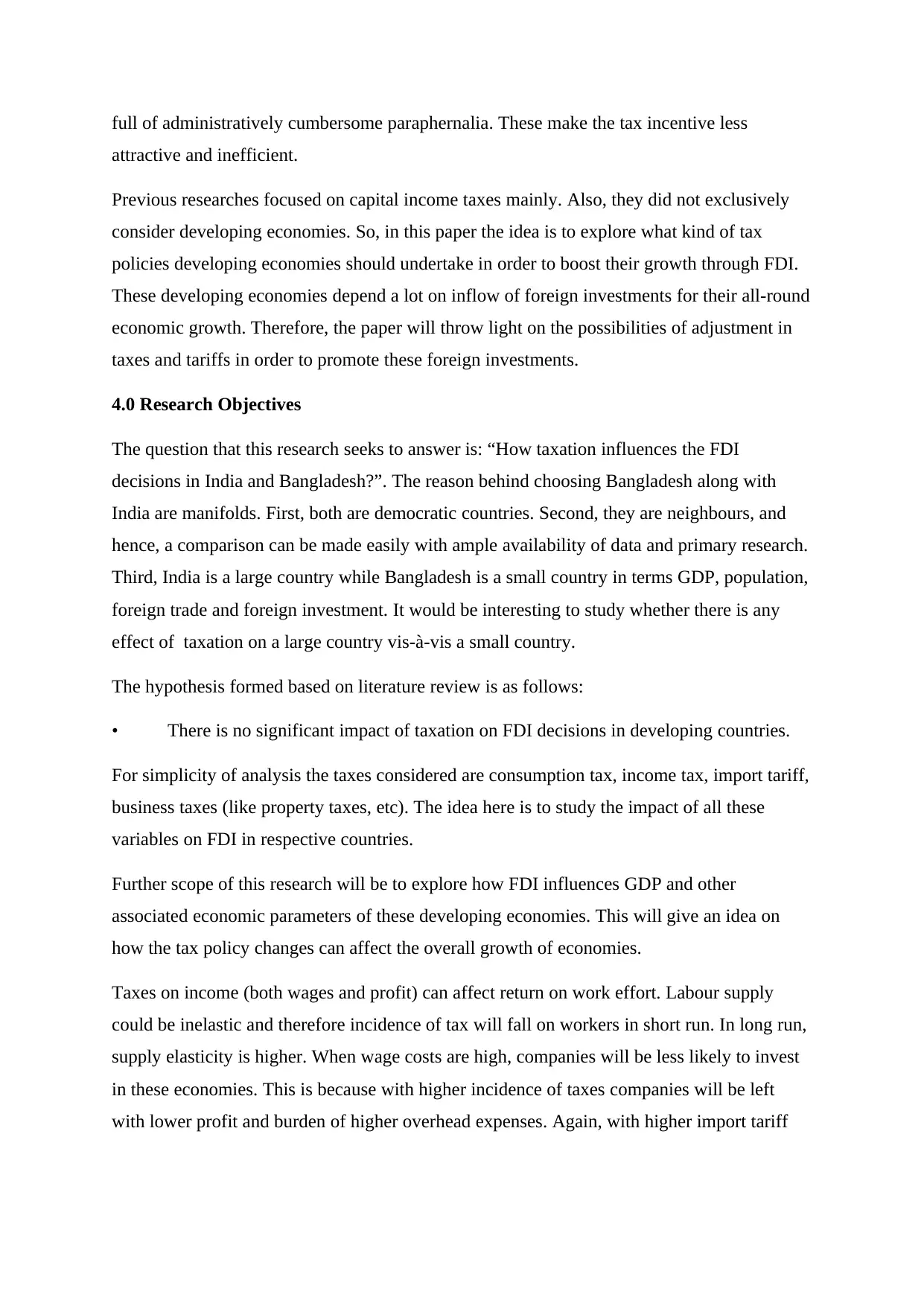
full of administratively cumbersome paraphernalia. These make the tax incentive less
attractive and inefficient.
Previous researches focused on capital income taxes mainly. Also, they did not exclusively
consider developing economies. So, in this paper the idea is to explore what kind of tax
policies developing economies should undertake in order to boost their growth through FDI.
These developing economies depend a lot on inflow of foreign investments for their all-round
economic growth. Therefore, the paper will throw light on the possibilities of adjustment in
taxes and tariffs in order to promote these foreign investments.
4.0 Research Objectives
The question that this research seeks to answer is: “How taxation influences the FDI
decisions in India and Bangladesh?”. The reason behind choosing Bangladesh along with
India are manifolds. First, both are democratic countries. Second, they are neighbours, and
hence, a comparison can be made easily with ample availability of data and primary research.
Third, India is a large country while Bangladesh is a small country in terms GDP, population,
foreign trade and foreign investment. It would be interesting to study whether there is any
effect of taxation on a large country vis-à-vis a small country.
The hypothesis formed based on literature review is as follows:
• There is no significant impact of taxation on FDI decisions in developing countries.
For simplicity of analysis the taxes considered are consumption tax, income tax, import tariff,
business taxes (like property taxes, etc). The idea here is to study the impact of all these
variables on FDI in respective countries.
Further scope of this research will be to explore how FDI influences GDP and other
associated economic parameters of these developing economies. This will give an idea on
how the tax policy changes can affect the overall growth of economies.
Taxes on income (both wages and profit) can affect return on work effort. Labour supply
could be inelastic and therefore incidence of tax will fall on workers in short run. In long run,
supply elasticity is higher. When wage costs are high, companies will be less likely to invest
in these economies. This is because with higher incidence of taxes companies will be left
with lower profit and burden of higher overhead expenses. Again, with higher import tariff
attractive and inefficient.
Previous researches focused on capital income taxes mainly. Also, they did not exclusively
consider developing economies. So, in this paper the idea is to explore what kind of tax
policies developing economies should undertake in order to boost their growth through FDI.
These developing economies depend a lot on inflow of foreign investments for their all-round
economic growth. Therefore, the paper will throw light on the possibilities of adjustment in
taxes and tariffs in order to promote these foreign investments.
4.0 Research Objectives
The question that this research seeks to answer is: “How taxation influences the FDI
decisions in India and Bangladesh?”. The reason behind choosing Bangladesh along with
India are manifolds. First, both are democratic countries. Second, they are neighbours, and
hence, a comparison can be made easily with ample availability of data and primary research.
Third, India is a large country while Bangladesh is a small country in terms GDP, population,
foreign trade and foreign investment. It would be interesting to study whether there is any
effect of taxation on a large country vis-à-vis a small country.
The hypothesis formed based on literature review is as follows:
• There is no significant impact of taxation on FDI decisions in developing countries.
For simplicity of analysis the taxes considered are consumption tax, income tax, import tariff,
business taxes (like property taxes, etc). The idea here is to study the impact of all these
variables on FDI in respective countries.
Further scope of this research will be to explore how FDI influences GDP and other
associated economic parameters of these developing economies. This will give an idea on
how the tax policy changes can affect the overall growth of economies.
Taxes on income (both wages and profit) can affect return on work effort. Labour supply
could be inelastic and therefore incidence of tax will fall on workers in short run. In long run,
supply elasticity is higher. When wage costs are high, companies will be less likely to invest
in these economies. This is because with higher incidence of taxes companies will be left
with lower profit and burden of higher overhead expenses. Again, with higher import tariff
Paraphrase This Document
Need a fresh take? Get an instant paraphrase of this document with our AI Paraphraser
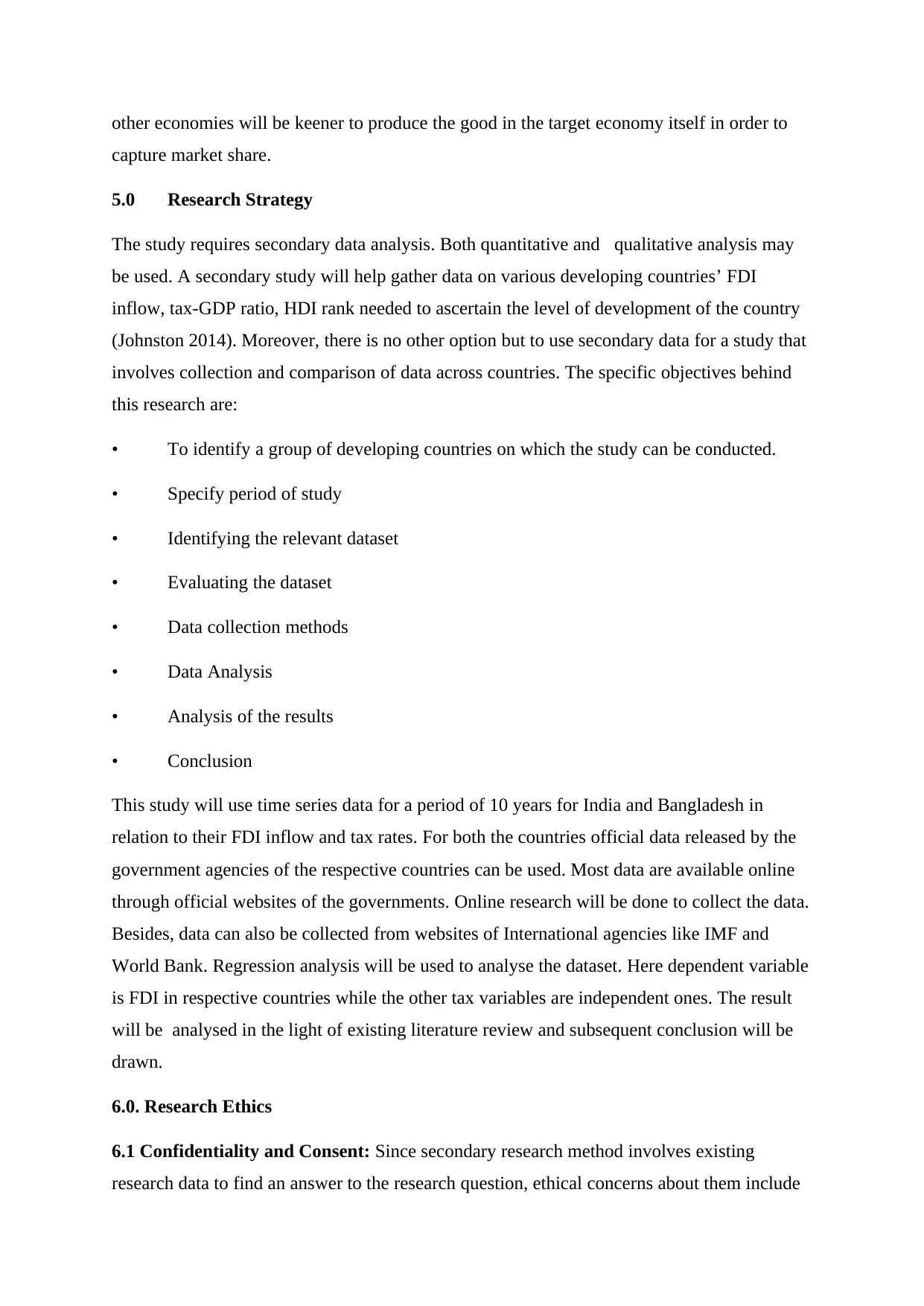
other economies will be keener to produce the good in the target economy itself in order to
capture market share.
5.0 Research Strategy
The study requires secondary data analysis. Both quantitative and qualitative analysis may
be used. A secondary study will help gather data on various developing countries’ FDI
inflow, tax-GDP ratio, HDI rank needed to ascertain the level of development of the country
(Johnston 2014). Moreover, there is no other option but to use secondary data for a study that
involves collection and comparison of data across countries. The specific objectives behind
this research are:
• To identify a group of developing countries on which the study can be conducted.
• Specify period of study
• Identifying the relevant dataset
• Evaluating the dataset
• Data collection methods
• Data Analysis
• Analysis of the results
• Conclusion
This study will use time series data for a period of 10 years for India and Bangladesh in
relation to their FDI inflow and tax rates. For both the countries official data released by the
government agencies of the respective countries can be used. Most data are available online
through official websites of the governments. Online research will be done to collect the data.
Besides, data can also be collected from websites of International agencies like IMF and
World Bank. Regression analysis will be used to analyse the dataset. Here dependent variable
is FDI in respective countries while the other tax variables are independent ones. The result
will be analysed in the light of existing literature review and subsequent conclusion will be
drawn.
6.0. Research Ethics
6.1 Confidentiality and Consent: Since secondary research method involves existing
research data to find an answer to the research question, ethical concerns about them include
capture market share.
5.0 Research Strategy
The study requires secondary data analysis. Both quantitative and qualitative analysis may
be used. A secondary study will help gather data on various developing countries’ FDI
inflow, tax-GDP ratio, HDI rank needed to ascertain the level of development of the country
(Johnston 2014). Moreover, there is no other option but to use secondary data for a study that
involves collection and comparison of data across countries. The specific objectives behind
this research are:
• To identify a group of developing countries on which the study can be conducted.
• Specify period of study
• Identifying the relevant dataset
• Evaluating the dataset
• Data collection methods
• Data Analysis
• Analysis of the results
• Conclusion
This study will use time series data for a period of 10 years for India and Bangladesh in
relation to their FDI inflow and tax rates. For both the countries official data released by the
government agencies of the respective countries can be used. Most data are available online
through official websites of the governments. Online research will be done to collect the data.
Besides, data can also be collected from websites of International agencies like IMF and
World Bank. Regression analysis will be used to analyse the dataset. Here dependent variable
is FDI in respective countries while the other tax variables are independent ones. The result
will be analysed in the light of existing literature review and subsequent conclusion will be
drawn.
6.0. Research Ethics
6.1 Confidentiality and Consent: Since secondary research method involves existing
research data to find an answer to the research question, ethical concerns about them include
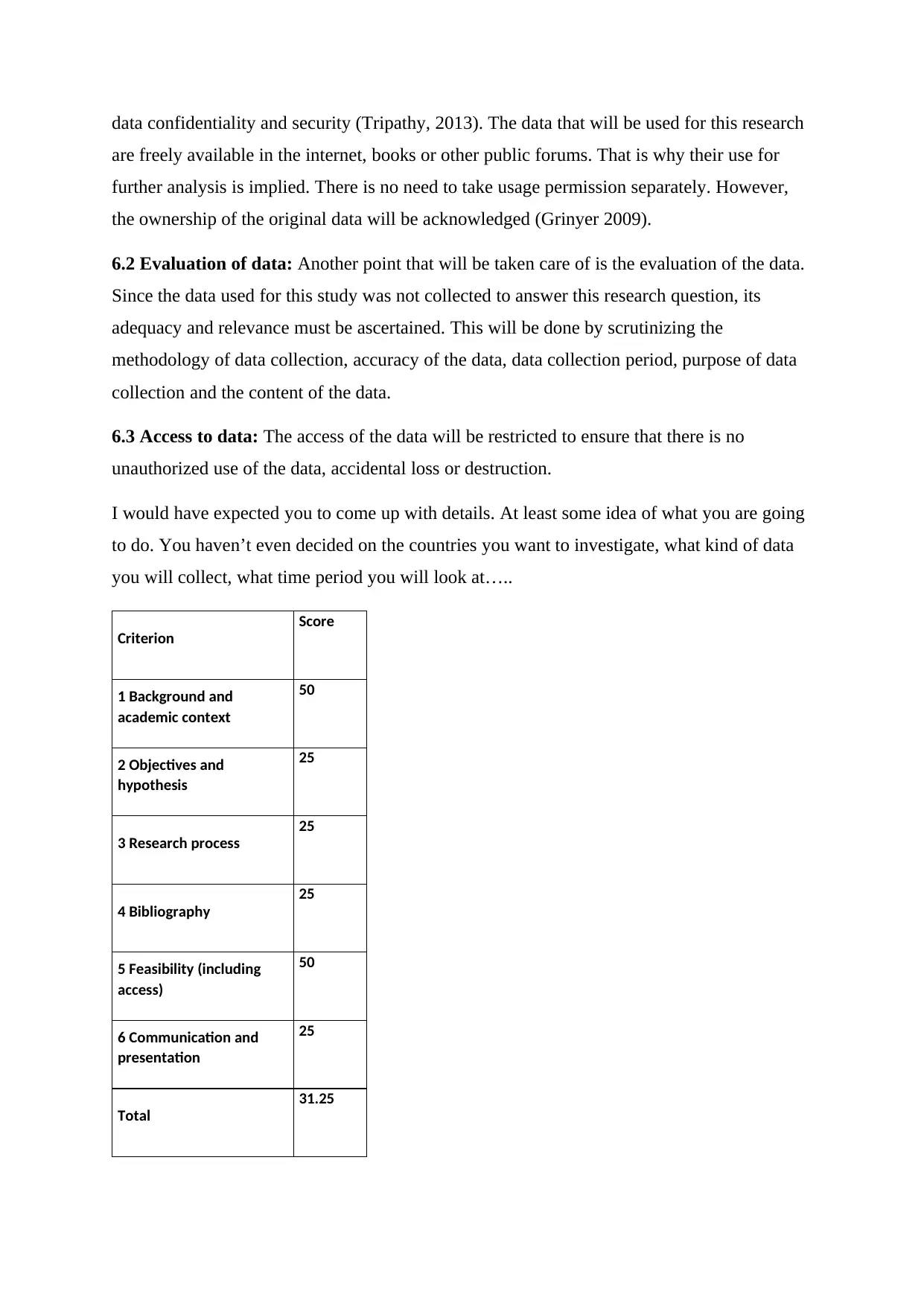
data confidentiality and security (Tripathy, 2013). The data that will be used for this research
are freely available in the internet, books or other public forums. That is why their use for
further analysis is implied. There is no need to take usage permission separately. However,
the ownership of the original data will be acknowledged (Grinyer 2009).
6.2 Evaluation of data: Another point that will be taken care of is the evaluation of the data.
Since the data used for this study was not collected to answer this research question, its
adequacy and relevance must be ascertained. This will be done by scrutinizing the
methodology of data collection, accuracy of the data, data collection period, purpose of data
collection and the content of the data.
6.3 Access to data: The access of the data will be restricted to ensure that there is no
unauthorized use of the data, accidental loss or destruction.
I would have expected you to come up with details. At least some idea of what you are going
to do. You haven’t even decided on the countries you want to investigate, what kind of data
you will collect, what time period you will look at…..
Criterion
Score
1 Background and
academic context
50
2 Objectives and
hypothesis
25
3 Research process
25
4 Bibliography
25
5 Feasibility (including
access)
50
6 Communication and
presentation
25
Total
31.25
are freely available in the internet, books or other public forums. That is why their use for
further analysis is implied. There is no need to take usage permission separately. However,
the ownership of the original data will be acknowledged (Grinyer 2009).
6.2 Evaluation of data: Another point that will be taken care of is the evaluation of the data.
Since the data used for this study was not collected to answer this research question, its
adequacy and relevance must be ascertained. This will be done by scrutinizing the
methodology of data collection, accuracy of the data, data collection period, purpose of data
collection and the content of the data.
6.3 Access to data: The access of the data will be restricted to ensure that there is no
unauthorized use of the data, accidental loss or destruction.
I would have expected you to come up with details. At least some idea of what you are going
to do. You haven’t even decided on the countries you want to investigate, what kind of data
you will collect, what time period you will look at…..
Criterion
Score
1 Background and
academic context
50
2 Objectives and
hypothesis
25
3 Research process
25
4 Bibliography
25
5 Feasibility (including
access)
50
6 Communication and
presentation
25
Total
31.25
⊘ This is a preview!⊘
Do you want full access?
Subscribe today to unlock all pages.

Trusted by 1+ million students worldwide
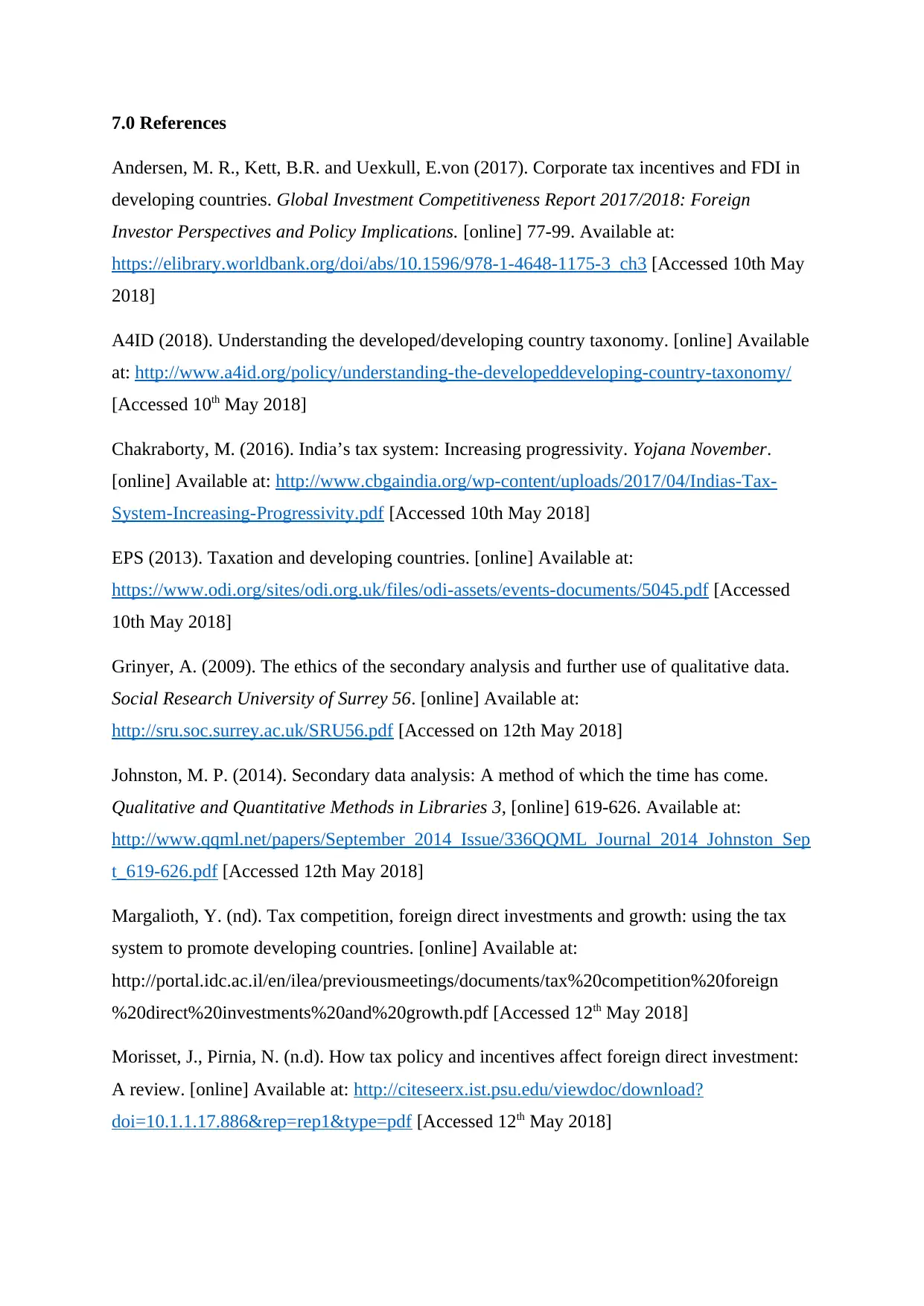
7.0 References
Andersen, M. R., Kett, B.R. and Uexkull, E.von (2017). Corporate tax incentives and FDI in
developing countries. Global Investment Competitiveness Report 2017/2018: Foreign
Investor Perspectives and Policy Implications. [online] 77-99. Available at:
https://elibrary.worldbank.org/doi/abs/10.1596/978-1-4648-1175-3_ch3 [Accessed 10th May
2018]
A4ID (2018). Understanding the developed/developing country taxonomy. [online] Available
at: http://www.a4id.org/policy/understanding-the-developeddeveloping-country-taxonomy/
[Accessed 10th May 2018]
Chakraborty, M. (2016). India’s tax system: Increasing progressivity. Yojana November.
[online] Available at: http://www.cbgaindia.org/wp-content/uploads/2017/04/Indias-Tax-
System-Increasing-Progressivity.pdf [Accessed 10th May 2018]
EPS (2013). Taxation and developing countries. [online] Available at:
https://www.odi.org/sites/odi.org.uk/files/odi-assets/events-documents/5045.pdf [Accessed
10th May 2018]
Grinyer, A. (2009). The ethics of the secondary analysis and further use of qualitative data.
Social Research University of Surrey 56. [online] Available at:
http://sru.soc.surrey.ac.uk/SRU56.pdf [Accessed on 12th May 2018]
Johnston, M. P. (2014). Secondary data analysis: A method of which the time has come.
Qualitative and Quantitative Methods in Libraries 3, [online] 619-626. Available at:
http://www.qqml.net/papers/September_2014_Issue/336QQML_Journal_2014_Johnston_Sep
t_619-626.pdf [Accessed 12th May 2018]
Margalioth, Y. (nd). Tax competition, foreign direct investments and growth: using the tax
system to promote developing countries. [online] Available at:
http://portal.idc.ac.il/en/ilea/previousmeetings/documents/tax%20competition%20foreign
%20direct%20investments%20and%20growth.pdf [Accessed 12th May 2018]
Morisset, J., Pirnia, N. (n.d). How tax policy and incentives affect foreign direct investment:
A review. [online] Available at: http://citeseerx.ist.psu.edu/viewdoc/download?
doi=10.1.1.17.886&rep=rep1&type=pdf [Accessed 12th May 2018]
Andersen, M. R., Kett, B.R. and Uexkull, E.von (2017). Corporate tax incentives and FDI in
developing countries. Global Investment Competitiveness Report 2017/2018: Foreign
Investor Perspectives and Policy Implications. [online] 77-99. Available at:
https://elibrary.worldbank.org/doi/abs/10.1596/978-1-4648-1175-3_ch3 [Accessed 10th May
2018]
A4ID (2018). Understanding the developed/developing country taxonomy. [online] Available
at: http://www.a4id.org/policy/understanding-the-developeddeveloping-country-taxonomy/
[Accessed 10th May 2018]
Chakraborty, M. (2016). India’s tax system: Increasing progressivity. Yojana November.
[online] Available at: http://www.cbgaindia.org/wp-content/uploads/2017/04/Indias-Tax-
System-Increasing-Progressivity.pdf [Accessed 10th May 2018]
EPS (2013). Taxation and developing countries. [online] Available at:
https://www.odi.org/sites/odi.org.uk/files/odi-assets/events-documents/5045.pdf [Accessed
10th May 2018]
Grinyer, A. (2009). The ethics of the secondary analysis and further use of qualitative data.
Social Research University of Surrey 56. [online] Available at:
http://sru.soc.surrey.ac.uk/SRU56.pdf [Accessed on 12th May 2018]
Johnston, M. P. (2014). Secondary data analysis: A method of which the time has come.
Qualitative and Quantitative Methods in Libraries 3, [online] 619-626. Available at:
http://www.qqml.net/papers/September_2014_Issue/336QQML_Journal_2014_Johnston_Sep
t_619-626.pdf [Accessed 12th May 2018]
Margalioth, Y. (nd). Tax competition, foreign direct investments and growth: using the tax
system to promote developing countries. [online] Available at:
http://portal.idc.ac.il/en/ilea/previousmeetings/documents/tax%20competition%20foreign
%20direct%20investments%20and%20growth.pdf [Accessed 12th May 2018]
Morisset, J., Pirnia, N. (n.d). How tax policy and incentives affect foreign direct investment:
A review. [online] Available at: http://citeseerx.ist.psu.edu/viewdoc/download?
doi=10.1.1.17.886&rep=rep1&type=pdf [Accessed 12th May 2018]
Paraphrase This Document
Need a fresh take? Get an instant paraphrase of this document with our AI Paraphraser
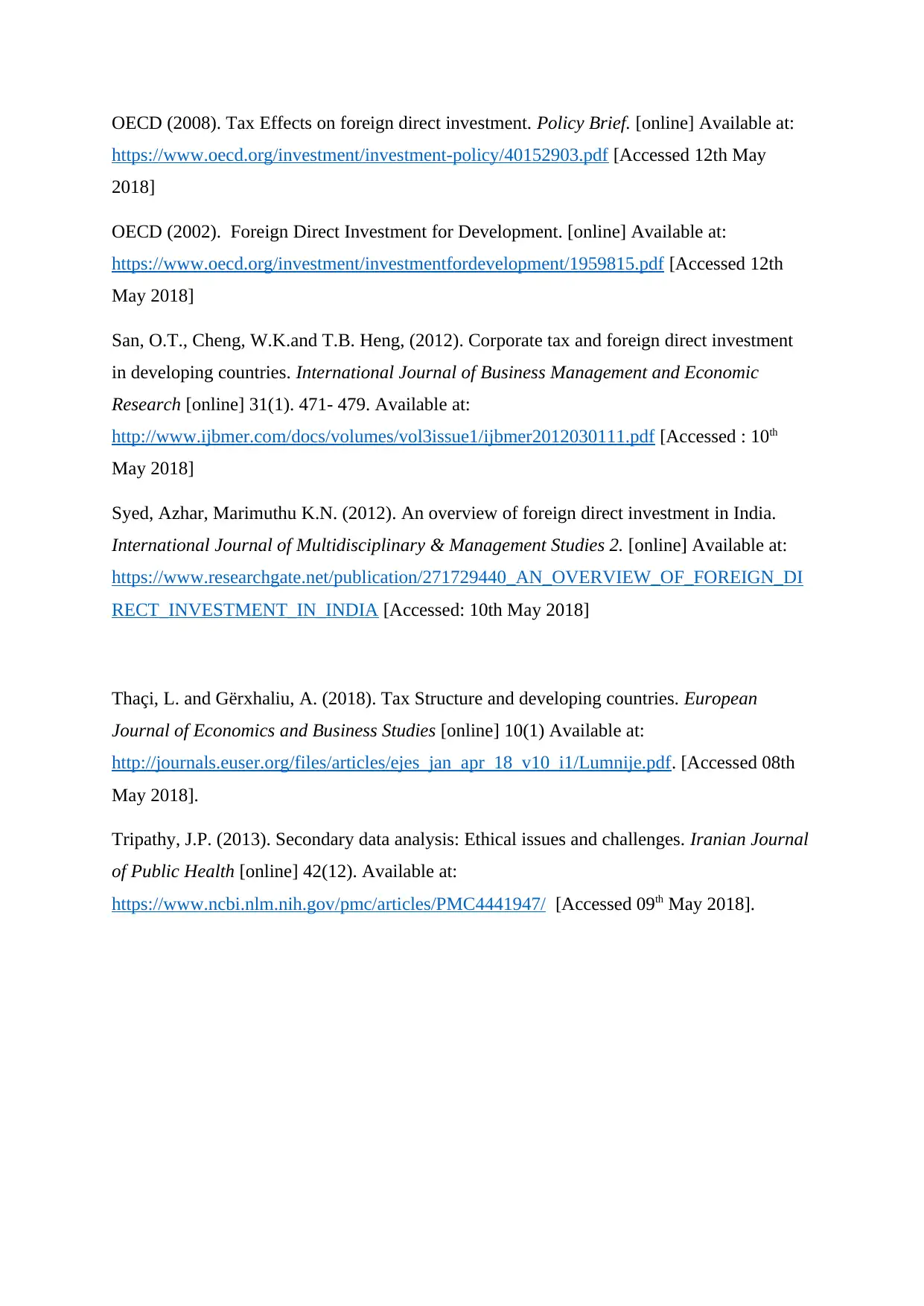
OECD (2008). Tax Effects on foreign direct investment. Policy Brief. [online] Available at:
https://www.oecd.org/investment/investment-policy/40152903.pdf [Accessed 12th May
2018]
OECD (2002). Foreign Direct Investment for Development. [online] Available at:
https://www.oecd.org/investment/investmentfordevelopment/1959815.pdf [Accessed 12th
May 2018]
San, O.T., Cheng, W.K.and T.B. Heng, (2012). Corporate tax and foreign direct investment
in developing countries. International Journal of Business Management and Economic
Research [online] 31(1). 471- 479. Available at:
http://www.ijbmer.com/docs/volumes/vol3issue1/ijbmer2012030111.pdf [Accessed : 10th
May 2018]
Syed, Azhar, Marimuthu K.N. (2012). An overview of foreign direct investment in India.
International Journal of Multidisciplinary & Management Studies 2. [online] Available at:
https://www.researchgate.net/publication/271729440_AN_OVERVIEW_OF_FOREIGN_DI
RECT_INVESTMENT_IN_INDIA [Accessed: 10th May 2018]
Thaçi, L. and Gërxhaliu, A. (2018). Tax Structure and developing countries. European
Journal of Economics and Business Studies [online] 10(1) Available at:
http://journals.euser.org/files/articles/ejes_jan_apr_18_v10_i1/Lumnije.pdf. [Accessed 08th
May 2018].
Tripathy, J.P. (2013). Secondary data analysis: Ethical issues and challenges. Iranian Journal
of Public Health [online] 42(12). Available at:
https://www.ncbi.nlm.nih.gov/pmc/articles/PMC4441947/ [Accessed 09th May 2018].
https://www.oecd.org/investment/investment-policy/40152903.pdf [Accessed 12th May
2018]
OECD (2002). Foreign Direct Investment for Development. [online] Available at:
https://www.oecd.org/investment/investmentfordevelopment/1959815.pdf [Accessed 12th
May 2018]
San, O.T., Cheng, W.K.and T.B. Heng, (2012). Corporate tax and foreign direct investment
in developing countries. International Journal of Business Management and Economic
Research [online] 31(1). 471- 479. Available at:
http://www.ijbmer.com/docs/volumes/vol3issue1/ijbmer2012030111.pdf [Accessed : 10th
May 2018]
Syed, Azhar, Marimuthu K.N. (2012). An overview of foreign direct investment in India.
International Journal of Multidisciplinary & Management Studies 2. [online] Available at:
https://www.researchgate.net/publication/271729440_AN_OVERVIEW_OF_FOREIGN_DI
RECT_INVESTMENT_IN_INDIA [Accessed: 10th May 2018]
Thaçi, L. and Gërxhaliu, A. (2018). Tax Structure and developing countries. European
Journal of Economics and Business Studies [online] 10(1) Available at:
http://journals.euser.org/files/articles/ejes_jan_apr_18_v10_i1/Lumnije.pdf. [Accessed 08th
May 2018].
Tripathy, J.P. (2013). Secondary data analysis: Ethical issues and challenges. Iranian Journal
of Public Health [online] 42(12). Available at:
https://www.ncbi.nlm.nih.gov/pmc/articles/PMC4441947/ [Accessed 09th May 2018].
1 out of 8
Related Documents
Your All-in-One AI-Powered Toolkit for Academic Success.
+13062052269
info@desklib.com
Available 24*7 on WhatsApp / Email
![[object Object]](/_next/static/media/star-bottom.7253800d.svg)
Unlock your academic potential
Copyright © 2020–2025 A2Z Services. All Rights Reserved. Developed and managed by ZUCOL.





